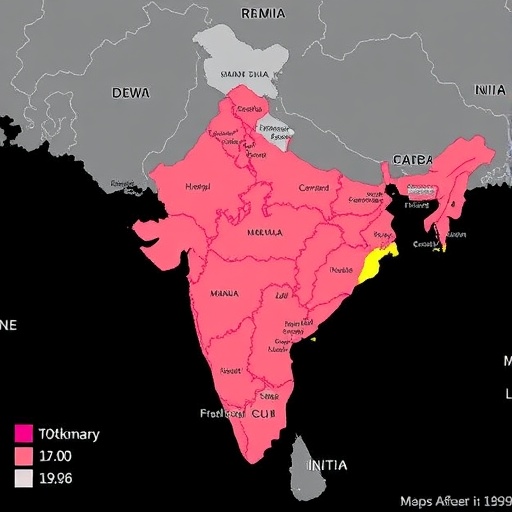A groundbreaking study has delivered the most detailed global map to date outlining the risk landscape of chikungunya virus infections, spotlighting India as a nation poised to bear the most substantial long-term health burden from this mosquito-borne pathogen. Conducted by a collaborative team from the London School of Hygiene & Tropical Medicine (LSHTM), Nagasaki University, and the International Vaccine Institute in Seoul, this research utilized advanced computational modeling to predict and quantify the yearly at-risk populations and potential infection rates worldwide.
Leveraging machine learning techniques, the team synthesized extensive epidemiological data concerning chikungunya infections with environmental and socioeconomic variables, such as the distribution of Aedes aegypti and Aedes albopictus mosquitoes, regional temperature profiles conducive to viral transmission, annual precipitation rates, habitat suitability indices, and national Gross Domestic Product (GDP) indicators. This multifactorial approach enabled an unprecedented projection of the disease’s geographic reach beyond traditional tropical and subtropical zones, emphasizing that the threat posed by chikungunya extends far into previously unsuspected regions.
The model estimated that globally, approximately 14.4 million individuals face an annual risk of contracting chikungunya under current conditions. However, accounting for possible geographic expansion of risk zones and emerging case reports, that figure could escalate dramatically to nearly 35 million people at risk each year. India alone represents a significant fraction of this burden, with 5.1 million individuals currently identified at risk and a potential increase to 12.1 million under future spread scenarios.
Importantly, this research illuminated that India, Brazil, and Indonesia emerge as the top three countries most vulnerable to enduring, severe consequences from chikungunya infection. These nations are expected to endure nearly half (48%) of the global health impact from the virus. Unlike many infectious diseases where acute morbidity and mortality dominate, chikungunya’s primary burden arises from chronic sequelae. Approximately 50% of those infected develop persistent disability, chiefly manifested as debilitating joint pain that can persist for months or even years after the initial febrile illness.
The clinical presentation of chikungunya typically includes sudden onset of high fever exceeding 39℃, accompanied by severe polyarthralgia disproportionately affecting hand, wrist, ankle, and foot joints. While acute symptoms generally subside within weeks, the pain and stiffness can transition to a protracted chronic syndrome that significantly reduces quality of life. Fatalities are infrequent but have been documented, predominantly in elderly or immunocompromised individuals.
This novel modeling study contrasted previous attempts to quantify chikungunya’s burden, which largely depended on underreported surveillance and outbreak data, often failing to capture asymptomatic or mildly symptomatic cases, thereby underestimating true incidence. Instead, the force of infection concept, which integrates not only infection counts but also transmission dynamics and vector ecology, was harnessed to estimate realistic infection probabilities in populations at risk.
Findings indicated that while the average annual risk of infection per susceptible person hovered around 1.2–1.3%, certain hotspots exhibited notably higher rates. For example, in Gabon, Central Africa, up to 11% of residents living in at-risk areas might contract the virus annually, signaling substantial localized epidemics that could overwhelm healthcare infrastructures.
Age-stratified analyses revealed differential vulnerabilities along the lifespan. Middle-aged adults, particularly those between 40 and 60 years old, accounted for the majority of chronic disability burden, emphasizing this group’s high risk for long-term morbidity. In contrast, children under 10 and the elderly over 80 were most susceptible to acute manifestations of chikungunya infection, underscoring the nuanced interplay between age and disease outcomes.
The expanding global footprint of vector species capable of transmitting chikungunya poses significant challenges for public health preparedness. Aedes aegypti and Aedes albopictus mosquitoes, commonly known as yellow fever and tiger mosquitoes, have been recorded in more than 114 countries since the virus’s resurgence in 2004. Their adaptation to temperate climates, urban landscapes, and varying precipitation patterns facilitates the virus’s potential entry into new territories.
Researchers caution that their model reflects a long-term average and does not incorporate extreme weather anomalies or evolving climatic trends, which could alter vector populations and transmission dynamics unpredictably. Consequently, continuous surveillance and adaptive response frameworks remain paramount to mitigate emerging chikungunya threats.
The absence of specific antiviral therapies against chikungunya compounds the urgency for effective prevention interventions. To date, supportive care addressing symptoms represents the primary clinical management strategy. Encouragingly, two vaccines, identified as Ixchiq® and Vimkunya®, have received approval for use in various countries, including Brazil. The researchers advocate for leveraging their detailed risk maps to strategically target vaccine deployment, prioritizing age groups and regions identified as most vulnerable.
Co-author Hyolim Kang emphasized the paradigm shift from considering chikungunya a geographically confined threat to recognizing its potential as a pervasive global health hazard. Sushant Sahastrabuddhe from the International Vaccine Institute highlighted the study’s real-time utility, underscoring the imperative that scientific insights must translate to actionable public health measures swiftly.
Ultimately, this pioneering force of infection mapping and spatial modeling study charts a path for stakeholders—from governments to global health agencies like the WHO—to anticipate and curtail chikungunya’s expanding impact. Through informed resource allocation and proactive immunization campaigns, the global community moves closer to mitigating the substantial and lingering human costs wrought by this resurging virus.
Subject of Research:
Global and national burden of chikungunya virus infection and its long-term impacts
Article Title:
Global, regional, and national burden of chikungunya: force of infection mapping and spatial modelling study
News Publication Date:
1-Oct-2025
Keywords:
Health and medicine, Diseases and disorders, Infectious diseases
Tags: advanced computational modeling in disease predictionAedes aegypti and Aedes albopictus distributionannual infection rates of chikungunyachikungunya virus impact in Indiaenvironmental factors affecting chikungunya transmissiongeographic expansion of chikungunya riskglobal risk map for chikungunyahealth burden of chikungunyamachine learning in epidemiologymosquito-borne diseases in Indiapublic health implications of chikungunyasocioeconomic variables and disease spread





